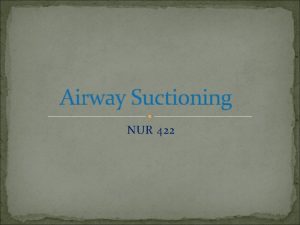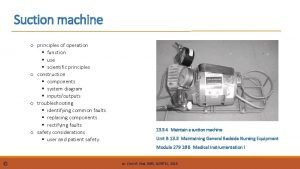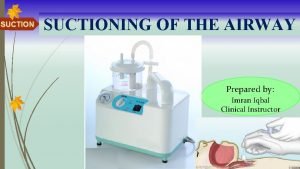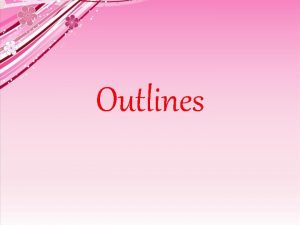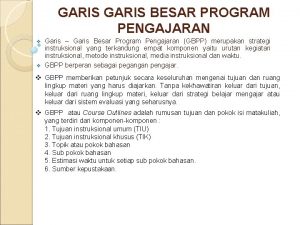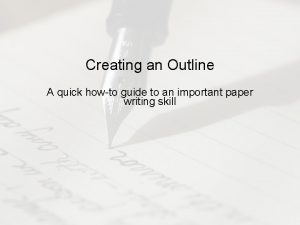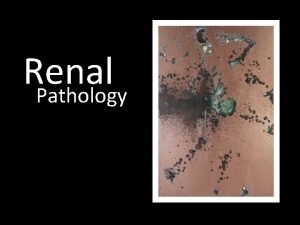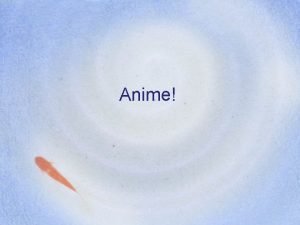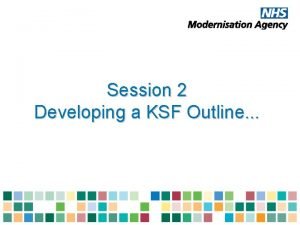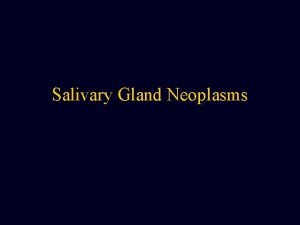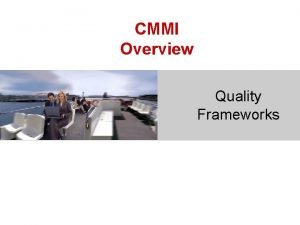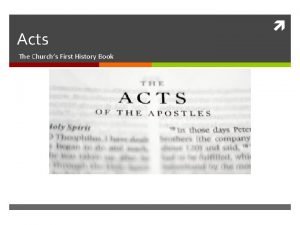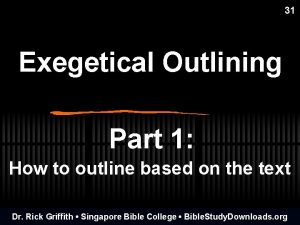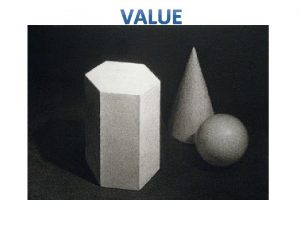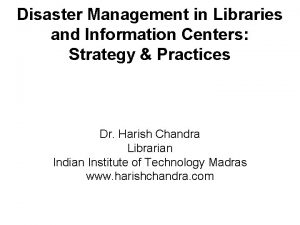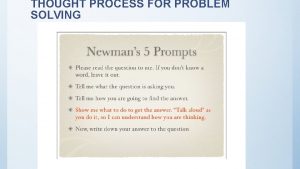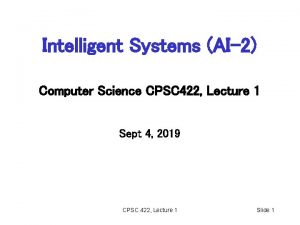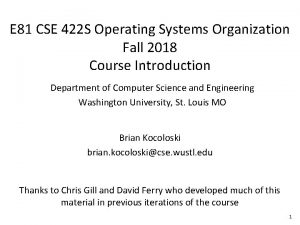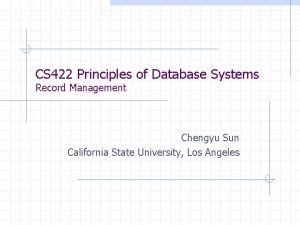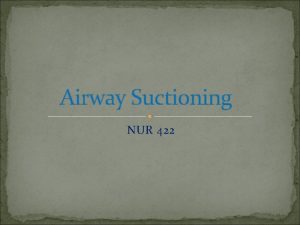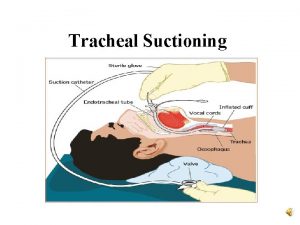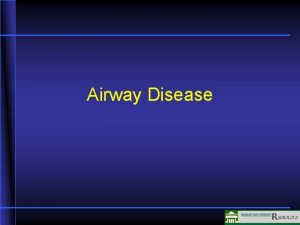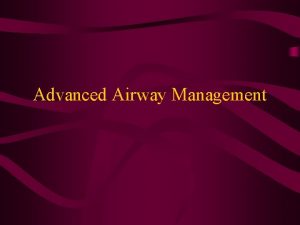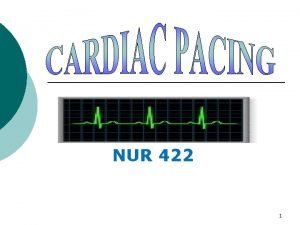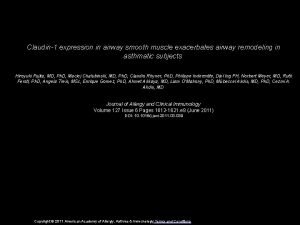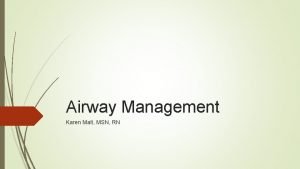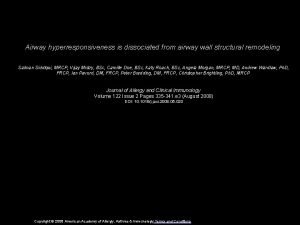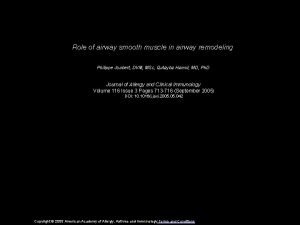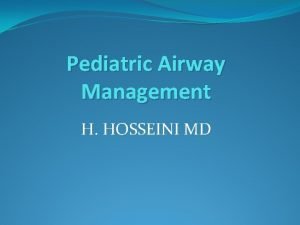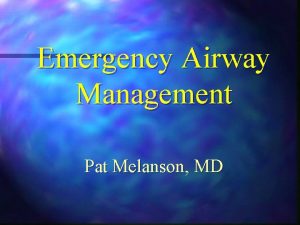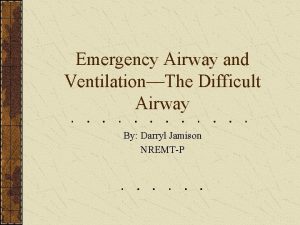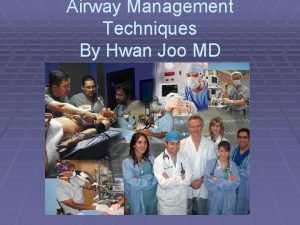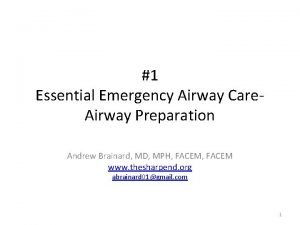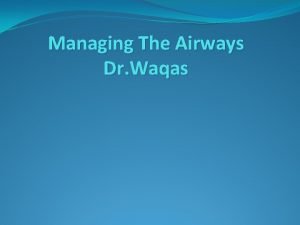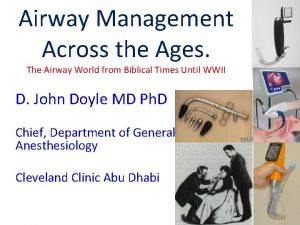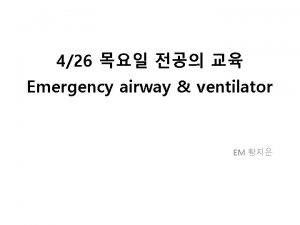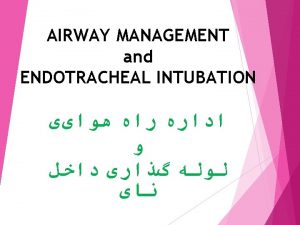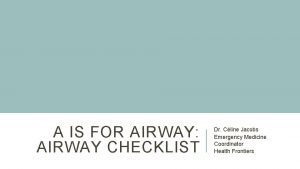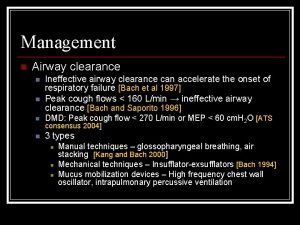Airway Suctioning NUR 422 Outlines 1 Definition of




























- Slides: 28

Airway Suctioning NUR 422

Outlines 1 - Definition of suctioning. 2 - Sites for suction. 3 - Deferent between oropharengyeal / nasopharyngeal suctioning and endotracheal / tracheostomy suctioning. 4 - Purposes for suctioning. 5 - Indications for suctioning. 6 - Choosing the right size catheter.

Outlines Cont’ 7 - Setting the correct pressure. 8 - The procedure. 9 - Documentation. 10 - Complications of suctioning. 11 - Techniques to minimize or decrease the complications.

Suctioning Definition Aspirating secretion through a catheter connected to a suction machine or wall suction outlet.

Nasopharyngeal Oropharyngeal Sites for Suctioning Endotracheal. Tracheostomy

Deferent between Oropharyngeal /Nasopharyngeal suctioning and Endotracheal/ tracheostomy suctioning Oropharyngeal /Nasopharyngeal suctioning Endotracheal/Tracheostomy suctioning Remove secretion from the upper respiratory tract. Remove secretion from the trachea and bronchi or the lower respiratory tract.

Oral / Nasal suction 1 - maintain oral/ nasal hygiene. 2 - comfort for the patient. 3 - remove blood and vomit in an emergency situation. P U R P O S E S of S u C T I O N I N G Tracheal/ Endotracheal suction Remove pulmonary secretions in patients who are unable to cough and clear their own secretions effectively.

Indications Oropharyngeal and Nasopharyngeal suctioning required for: 1 - Patient who has undergone head and neck surgery. 2 - Signs of respiratory distress. 3 - Evidence of unable to cough up and expectorate secreations.

Indications Cont’ 5 - Obtain sample of secretion for diagnostic purposes 6 - Prevent infection. Tracheal suctioning required for : 1 - Patients unable to clear their secretions themselves. 2 - patients with mechanical ventilation.

Choosing the Right Size Catheter Adult Children Infant Size #12 to #18 #8 to # 10 # 5 to #8 • Half the diameter (or less) of the tracheal tube.

Choosing the Right Size Catheter Cont’ Tow types of suctioning catheter : 1 - Whistle – tipped catheter. 2 - Open – tipped catheter. whistle – tipped catheter open – tipped catheter Less irritate the airway More effective for removing thick mucus plugs.


Setting the Correct Pressure Adult Wall Unit 100 to 120 mm Hg. Portable Unite 10 to 15 mm Hg Child 95 to 110 mm Hg. 5 to 10 mm Hg Infant 50 to 95 mm Hg. 2 to 5 mm Hg

The procedure E Q U I P M E N T 1 - Towel or moisture – resistant pad. 2 - Portable or wall suctioning machine with tubing and collection receptor. 3 - sterile deposable container for fluids. 4 - Sterile normal saline or water.

The procedure Cont’ E Q U I P M E N T 5 - Sterile gloves. 6 - Goggles or face shield. 7 - Sterile Suction Catheter kit. 8 - Water – soluble lubricant. 10 - sterile gauzes. 11 - Moisture resistant disposable bag. 12 - Sputum trap.

The procedure Cont’ 4 - position the patient. Conscious patient Unconscious patient Semi – Fowler’s position Lateral position and the with: patient facing you. ühead turned to one side for oral suctioning. üFor nasal suctioning with the neck hyperextended.


The procedure Cont’ 5 - prepare the equipment. 6 - make approximate measure of the depth for the insertion of the catheter and test the equipment. 7 - lubricate and introduce the catheter :

The procedure Cont’ § For Oropharyngeal suctioning : üPull the tongue forward. üDo not apply suction during insertion. üAdvance the catheter about 10 to 15 cm along on side of the mouth into oropharynx.

The procedure Cont’ § For Nasopharyngeal suction üAdvance the catheter along the nasal cavity with out suctioning. ü Never force the catheter against an obstruction.

The procedure Cont’ 8 - Perform suctioning. 9 - clean the catheter and apply suction again : üWipe off the catheter with sterile gauze. üFlash the catheter with sterile water or saline. üRelubricate the catheter and repeat suctioning until the air passage is clear.

The procedure Cont’ üAllow 20 t 0 30 second intervals between each suction and limit suctioning to 5 minutes in total. üAlternate nares for repeat suctioning. üEncourage the client to breath deeply and to cough between suctioning.

The procedure Cont’ 10 – Obtain specimen if required. 11 - promote the patient comfort. 12 - Dispose of equipment and ensure availability for the next suction. 13 - Assess the effectiveness of suctioning.

The procedure Cont’ 11 - promote the patient comfort. 12 - Dispose of equipment and ensure availability for the next suction. 13 - Assess the effectiveness of suctioning.

Documentation • Record the procedure : ØThe amount. ØConsistency. ØColor. ØOdor of the mucus. ØClient breathing status before and after. • If the technique is carried out frequently it may be appropriate to record only once , how ever the frequency of suctioning must be record

Trauma to the airway Hypoxemia Complications Nosocomial infection Cardiac dysrhythmia

Techniques to Minimize or Decrease the Complications 1 - Suction only as needed. 2 - sterile technique. 3 - Hyperinflation. 4 - Hyperoxygenation. 5 - safe catheter size. 6 - No saline instillation.

Thank you for your listening
 Laryngoscopy view grades
Laryngoscopy view grades Nasopharyngeal suctioning definition
Nasopharyngeal suctioning definition Suction machine diagram
Suction machine diagram Types of suction catheter
Types of suction catheter What is coordination in outlining
What is coordination in outlining Outline learning objectives
Outline learning objectives Kairos talk outlines
Kairos talk outlines Commercial law outlines
Commercial law outlines Four main components for effective outlines
Four main components for effective outlines A business plan is a document that outlines
A business plan is a document that outlines Pathology outline
Pathology outline 2 kings 4 8 17 sermon
2 kings 4 8 17 sermon Anima outline
Anima outline Two types of outlines
Two types of outlines Summary of a haunted house by virginia woolf
Summary of a haunted house by virginia woolf Ksf outlines
Ksf outlines Mucoepidermoid carcinoma histology
Mucoepidermoid carcinoma histology Cmmi model outlines
Cmmi model outlines Book of acts study outline
Book of acts study outline Exegetical sermon outlines
Exegetical sermon outlines Cjis security awareness
Cjis security awareness Mun position paper outline
Mun position paper outline Define visible
Define visible Congestion intestinal
Congestion intestinal A clear concise document which outlines preventive
A clear concise document which outlines preventive A library has 6 422 music cds stored on 26 shelves
A library has 6 422 music cds stored on 26 shelves Cpsc 422
Cpsc 422 Cse 422
Cse 422 Cs 422
Cs 422

